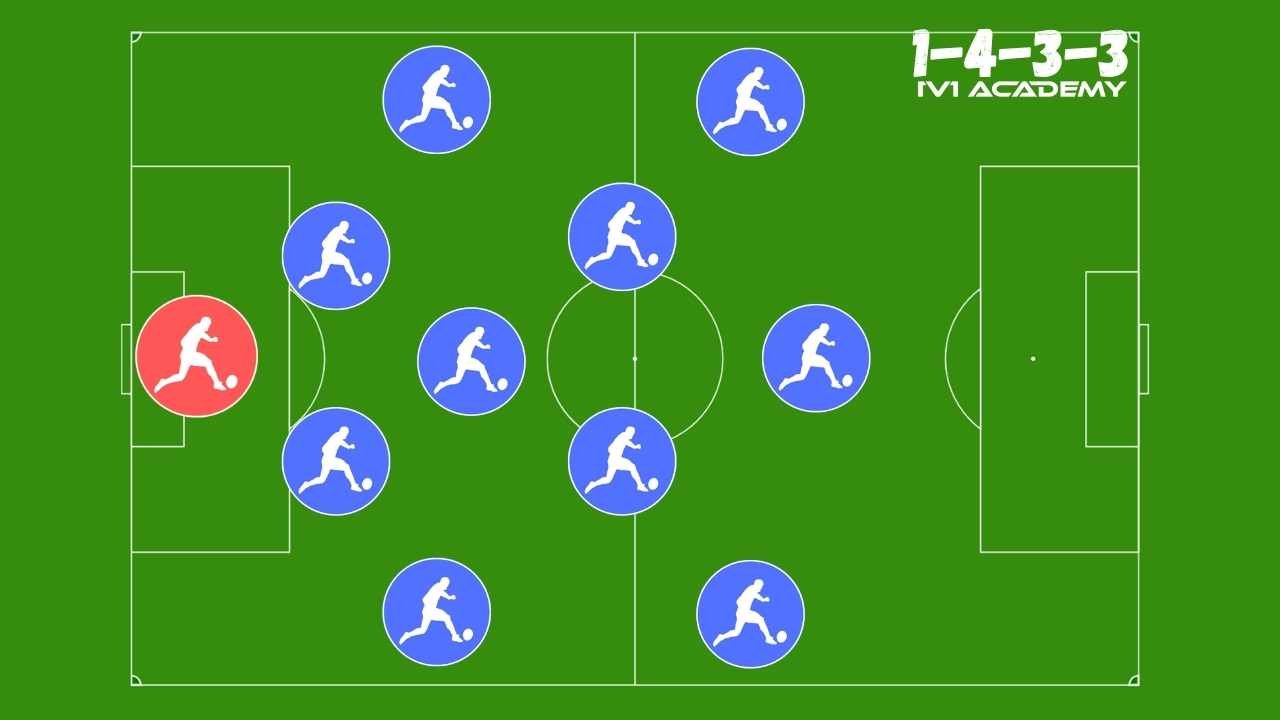
Play to listen to the article.
By Rudy Glez
1v1Academy. An Online Soccer Academy
The 4-3-3 soccer formation is one of the most popular systems of play used in soccer today. It is an attacking formation that looks to dominate possession and create scoring opportunities. This formation has one goalkeeper, four defenders, three midfielders, and three forwards. Let’s look at how this formation works and how you can implement it with your team.
What is the 4-3-3 soccer formation?
The 4-3-3 soccer formation is a system of play that emphasizes attacking and possession. It consists of four defenders, three midfielders, and three forwards. The four defenders are typically split into two center-backs and two full-backs. The midfielders consist of one holding midfielder and two central mids, while the three forwards are usually a central forward and two wingers.

How does the 4-3-3 soccer formation work?
The 4-3-3 soccer formation creates numerical superiority in the midfield and attack. The holding midfielder provides cover for the defense while the central midfielders and wingers link up with the forward line to create scoring opportunities. The full-backs provide width and support to the wingers, while the center-backs stay back to defend against counterattacks.
The formation relies on quick passing and movement to break down the opposition’s defense. The three forwards provide a constant threat in the attacking third, and the wingers are crucial in creating crossing opportunities for the central striker.
How can I implement the 4-3-3 soccer formation with my team?
Implementing the 4-3-3 soccer formation with your team requires a lot of preparation and training. It’s essential to make sure your players understand their roles and responsibilities within the formation. You should also work on developing your team’s passing, movement, and attacking skills.
One effective way to implement the 4-3-3 soccer formation is to start with a solid defense. Ensure that your defenders are comfortable playing in a four-man backline and that your holding midfielder provides adequate cover. Once you have a solid defensive foundation, you can work on building your midfield and attack.
What strategies should I use with the 4-3-3 soccer formation?
The 4-3-3 soccer formation is an attacking formation that relies on possession and quick movement. One effective strategy is to use the wingers to move and stretch the opposition’s defense and create space for the central striker. The central midfielders can link with the forward line to create scoring opportunities.
Another strategy is to press the opposition high up the pitch. This can be done by having your forward line pressure the opposition defenders and forcing them to make mistakes. Your midfielders can then quickly win the ball back and launch a counterattack.

How can I adjust the 4-3-3 soccer formation to fit my team?
The 4-3-3 soccer formation can be adjusted to fit your team’s strengths and weaknesses. For example, if you have a strong midfield, you could play with two holding midfielders instead of one. Alternatively, if you have pacey wingers, adjust the formation to a 4-2-3-1 to provide more support for the central striker. Without the ball you can easily defend with a 4-1-4-1 defensive formation by pulling your wingers back to the midfield line.
The 4-3-3 soccer formation is an attacking system of play that requires a lot of preparation and training to implement effectively. With the right strategies and adjustments, it can be a very effective formation for dominating possession and creating scoring opportunities.
Crush Your Opponents with the 4-3-3 Soccer Formation
As a soccer coach, you’re always looking for ways to improve your team’s performance on the field. This system of play offers a range of advantages, including a strong attacking presence, a solid defensive structure, and flexibility in gameplay. In this tactical guide, we’ll show you how to make the most of the 4-3-3 formation and take your team to the next level.
Why choose the 4-3-3 formation?
The 4-3-3 formation offers several advantages over other systems of play. Its key strength lies in its attacking potential, with three forwards providing a constant threat to the opposition’s defense. Additionally, the midfielders offer both defensive cover and attacking support, allowing for a smooth transition from defense to attack. With four defenders at the back, the 4-3-3 formation offers a solid defensive structure that can withstand pressure from the opposition.
How to set up your team in the 4-3-3 formation
Setting up your team in the 4-3-3 formation requires careful consideration of your players’ strengths and weaknesses.
Tips on how to set up your team for success:
- Goalkeeper: Your goalkeeper should be a reliable shot-stopper with good communication skills and the ability to organize the defense. Look for a goalkeeper who is confident in the box and capable of making quick decisions and outstanding foot skills and ball control.
- Defenders: Your back four should be strong, disciplined, and capable of playing a high line when necessary. Look for defenders with good positioning, tackling ability, and speed.
- Midfielders: Your midfielders are the engine room of your team, providing both defensive cover and attacking support. Look for a mix of players with different skill sets, including defensive midfielders, box-to-box midfielders, and attacking midfielders.
- Forwards: Your three forwards should be versatile players with good movement off the ball and the ability to create chances for themselves and their teammates. Look for players who can play on the wings and through the middle, and who can finish clinically in front of goal.
Tips for playing in the 4-3-3 formation
- High Pressing: The 4-3-3 formation is ideal for high-pressing teams, as it allows your forwards to put pressure on the opposition’s defense and force turnovers. Encourage your midfielders to support the forwards in pressing the opposition, and to be quick to recover if possession is lost.
- Quick Transitions: The 4-3-3 formation is also effective for quick transitions from defense to attack, as the midfielders and forwards can break forward quickly and support each other. Encourage your team to move the ball quickly and look for opportunities to counterattack.
- Flexibility: The 4-3-3 formation is a versatile system of play that can be adapted to suit different game situations. Encourage your players to be flexible and to switch positions if necessary to create space and exploit the opposition’s weaknesses.
The 4-3-3 soccer formation is a powerful system of play that can help your team dominate the opposition on the field. By setting up your team carefully and playing to its strengths, you can create a strong attacking presence while maintaining a solid defensive structure. Remember to be patient, work hard, and have fun – with the 4-3-3 formation, anything is possible.

When to Use the 4-3-3 Soccer Formation: A Guide for Coaches
As a soccer coach, one of your most important decisions is which formation to use for your team.
When to Use the 4-3-3 Formation
The 4-3-3 formation is ideal for teams that have strong attacking players. This formation allows for three forwards, giving your team a potent attacking force. It’s also a good choice for teams with a dominant central midfielder who can control the game and distribute the ball to the forwards.
The 4-3-3 soccer formation is a versatile and attacking formation that can be used by teams of all levels. When used correctly, it is an effective formation and can help teams dominate possession, create scoring opportunities, and maintain a solid defensive shape.
Here are some recommendations for when to use the 4-3-3 soccer formation according to your player’s capabilities:
When you have three strong and mobile forwards
The 4-3-3 formation relies heavily on the movement and attacking prowess of the three forwards. This formation is a good choice if you have three forwards who are quick, skillful, and can finish well. The forwards must work well together and make intelligent runs to create scoring chances.
When you have a solid and disciplined defensive line
The 4-3-3 formation leaves only four defenders to protect the goal, so they must be strong and disciplined. The two center backs will need to work well together and communicate effectively, while the fullbacks must provide support in attack and defense. If your defenders are not strong and disciplined, the 4-3-3 formation may leave your team vulnerable to counterattacks.
When you have three midfielders who can control the game
The three midfielders in the 4-3-3 formation are responsible for controlling the tempo of the game and providing support to both the attack and defense. If you have three midfielders who are comfortable on the ball, can pass accurately, and can break up opposition attacks, then this formation will work well. The holding midfielder, in particular, will need to be strong defensively and able to initiate attacks. The two center mids will need to be strong offensively and able to support the forwards.
When you want to dominate possession
The 4-3-3 formation is well-suited to teams that want to dominate possession and control the game. With three midfielders and three forwards, the team can maintain possession in the attacking third and create scoring opportunities. However, this requires a high technical ability and a willingness to take risks.
When you want to press high up the field
The 4-3-3 formation can press high up the field and disrupt opposition attacks. With three forwards pressing the opposition defenders and three midfielders providing support, the team can win the ball back in dangerous areas and create scoring opportunities. However, this requires a high fitness level and a willingness to work hard defensively. Because to recover the ball, the entire team must work together to press and cover all the players.

When Not to Use the 4-3-3 Formation
As a soccer coach or player, choosing the right system of play is critical for success on the field. The 4-3-3 formation can be a great choice, but it may only suit some teams.
Here are some tips on when to avoid this formation based on your players’ capabilities.
- Weak Defense: The 4-3-3 formation relies heavily on a solid defense to prevent the opposition’s attack. If your team’s defenders lack the skills and experience to handle the opposition’s forwards, there may be better choices than this formation. You need defenders capable of defending one-on-one, making crucial tackles, and intercepting the ball to stop the opposition’s attack.
- Lack of Midfield Depth: The 4-3-3 formation requires a solid and deep midfield to control the game and support the defense and the attack. If your team needs more midfielders with the necessary skills and stamina to cover a lot of ground, this formation may not work well for you.
- Limited Attacking Options: The 4-3-3 formation typically has three forwards, which can limit your attacking options. If your team doesn’t have versatile and skillful forwards who can create scoring opportunities on their own, you may struggle to score goals and break down the opposition’s defense.
- Inexperienced Team: If your team is inexperienced and still developing their skills and understanding of the game, the 4-3-3 formation may be too complex and challenging to execute effectively. It requires a high level of tactical awareness and discipline from all players, and if your team is not ready for this, it may lead to confusion and mistakes on the pitch.
- Lack of a Dominant Holding Midfielder: The 4-3-3 formation requires a dominant holding midfielder who can protect the defense, break up the opposition’s attacks, and support the midfield and attack. If your team has a player with the necessary skills and experience to play this position effectively, there may be better choices than this formation.
Final Thoughts
The 4-3-3 formation is popular for teams with strong attacking players and versatile midfielders. It can be an effective way to score goals and control the game. However, there are better choices for some teams. Consider your team’s strengths and weaknesses before deciding on a formation, and don’t be afraid to experiment to find the best fit.
Remember, the formation you choose is just one aspect of your team’s tactics. Effective coaching involves much more than simply selecting a formation. Focus on developing your players’ skills and teamwork, and you’ll be on your way to success.
Conclusion
In conclusion, the 4-3-3 soccer formation is a popular and effective system that can bring success to any team. Its attacking focus, midfield stability, and defensive cover make it a favorite of coaches and players worldwide. If you like to know more about the 4-3-3 formation and improve your skills on the field, then 1v1 Academy is the perfect resource for you.
At 1v1 Academy, we provide top-notch soccer education for players and coaches of all levels. Our expert trainers and coaches share their knowledge and experience with you, giving you the tools you need to excel on the field. From tactical strategies to technical skills, we cover every aspect of the game in our learning content.
To take your soccer training to the next level and expand your knowledge, follow 1v1 Academy on social media and consume our learning content regularly. Our engaging and informative videos, and articles will help you become a better player or coach.
So don’t wait any longer, join the 1v1 Academy community today. Start by visiting our website and subscribing to our social media channels and take the first step towards becoming a better player or coach.
1v1Academy. An Online Soccer Academy
